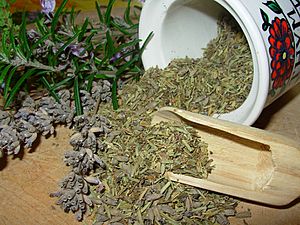Herbes de Provence facts for kids
Herbes de Provence (pronounced "erb duh pro-VAHNS") is a special mix of dried herbs. It comes from the Provence region in southeastern France. For a long time, people in Provence just used different herbs from their gardens or the wild. But in the 1970s, companies started selling these herbs already mixed together under the name "Herbes de Provence."
This mix usually includes herbs like savory, marjoram, rosemary, thyme, and oregano. If you buy Herbes de Provence in North America, you might also find lavender leaves in the mix! People often use these herbs to flavor grilled foods, like fish and meat, and also in yummy stews.
Contents
History of the Mix
For many years, people in Provence cooked with lots of different herbs. They would use herbs like thyme, rosemary, and savory that they gathered themselves. They didn't usually mix them all together and sell them as one product.
It wasn't until the 1970s that companies started creating and selling these specific herb mixtures. One of the first companies to do this was Ducros in France. So, even though the herbs have been used in Provence for a long time, the idea of buying them as a ready-made "Herbes de Provence" mix is quite new!
Where the Herbs Come From
The name "Herbes de Provence" is a general term for a mix of dried herbs. It's not a protected name, which means any company can use it, even if the herbs don't actually come from Provence.
In the past, many of these herbs were collected from the wild. But today, most of them are grown on farms by food companies. You can also grow these herbs at home in your garden or in pots on a balcony!
Even though the mix is called "Herbes de Provence," only a small amount of the dried herbs sold in France actually come from France. Most of the "Herbes de Provence" mixes you find in stores come from other countries, like Poland, Albania, countries in North Africa, or China.
What Herbs Are Used?
The most common herbs in these mixes are savory, marjoram, rosemary, thyme, and oregano.
As mentioned, in North America, you'll often find lavender leaves added to the mix. However, traditional Provençal recipes from a long time ago, like those in a famous cookbook from 1910 by Jean-Baptiste Reboul, didn't include lavender.
There's a special French quality label called Label Rouge that sets rules for some food products. For "Herbes de Provence" to get this label, the mix must contain specific amounts of each herb:
- 19% thyme
- 27% rosemary
- 27% savory
- 27% oregano
How They Are Sold
Since "Herbes de Provence" is a general name and not protected by law, there's no guarantee that the herbs in the mix actually grew in Provence. As we learned, most of these mixes come from other parts of the world.
You can often find "Herbes de Provence" sold in larger bags compared to other herbs. In the Provence region itself, these herb mixes are usually much cheaper than other dried herbs.
How to Use Herbes de Provence
Herbes de Provence are great for adding flavor to many dishes!
- You can sprinkle them on grilled foods like fish, chicken, or other meats.
- They are also perfect for vegetable stews, adding a warm, earthy taste.
- You can add the mix to your food before, during, or after cooking.
- Another way to use them is to mix them with cooking oil before you start cooking. This helps the flavors soak into the food.
- You can even sprinkle them on raw foods, like salads, vinaigrettes (salad dressings), or fresh cheese for a burst of flavor.
See also
 In Spanish: Hierbas provenzales para niños
In Spanish: Hierbas provenzales para niños


